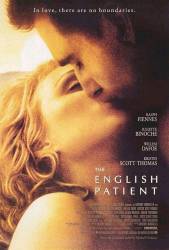Factual error: After Hardy dies and they're going through his possessions, a football scarf is pulled from his kit bag. The scarf has a Sunderland AFC badge. The film is set in World War II. The badge on the scarf was introduced in the 1970s.
Continuity mistake: After Almasy comes out from the desert, he goes to the British soldiers. They offer him a half glass of water. As they hand him the water, there is a scene change, but the water now is a full glass.
Continuity mistake: In the scene where Willem Dafoe is conversing with another male British agent as the German paratroopers invade, a British female worker passes him as he is about to go down the flight of stairs. As he reaches the ground floor, she passes by him again as she goes up the same stairs he just came down - seemingly far too quick to be possible.
Visible crew/equipment: At the very end of the movie, just before the credits, there is an aerial scene of the desert like the one at the beginning. At the bottom left of the screen you can see the knee of the cameraman (in jeans) for about 1 or 2 seconds.
Continuity mistake: In the scene where Almacy is trying to dig out the workers from the car in the sand dune, the camera switches back and forth between Almacy and Katherine as they talk. Each time the camera shows Almacy, the long white scarf around his neck is wrapped or dangling in a different way, and missing entirely at the end, as if they were tired of messing with it.
Continuity mistake: In the airplane crash scene, the stunt plane's fuselage appears to be seriously damaged. But when Fiennes runs up to the airplane to pull out the Cliftons, the fuselage looks relatively undamaged.
Deliberate mistake: The actual Lazlo Almasy died in the 1950's after voluntarily serving with the German Army and SS during WWII.
Factual error: Prochnow is addressed as "Major," in English, but he wears the collar tabs of an SS lieutenant colonel. He should've been addressed as "Obersturmbannfuhrer," or, in English, as "Colonel," because lieutenant colonels are acceptably addressed as "Colonel," as are full colonels.
Suggested correction: Obersturmbannfuher is also incorrect. The single oak leaf on each lapel of the uniform is the insignia for a full Colonel or Standartenführer. Therefore it would be acceptable to address him as Colonel because that is his rank.
This isn't a valid correction because you're agreeing he was called by the wrong rank. If you disagree with the word and want to make the entry more clear, do a word change.
Factual error: In the interrogation scene with Carravaggio, the SS officer (incorrectly addressed as the Wehrmacht equivalent "Herr Major") does not have the correct collar insignias. For a Sturmbannführer they should have four small squares on the black background.
Plot hole: It's unusual for Juliette Binoche's nurse to have a beautiful blue dress on when she retires with "her" patient to the abandoned monastery. Maybe it was an artistic homage by the film's director to her marvelous leading role in the movie, "Blue." However, given the unstable situation in post-war Italy, shouldn't she still be wearing her British khaki Army uniform?
Factual error: The bird calls used in the film, such as the Cactus Wren, are from the USA, not Tunisia and Italy where the film is set.
Continuity mistake: In the desert, early in the morning, Catherine's husband is heading for his plane, but Almasy wants to talk to him. Between them, on the ground, is a box, but from the other shot, the box is gone.
Factual error: In the interrogation scene with Carravaggio, the German officer is addressed by the private Wehrmacht soldier as "Herr major". The officer is SS. By his shoulder patches he indeed has the equivalent rank of a major, but the correct SS rank is "Sturmbannführer". SS officers were never addressed as "Herr", but simply with the rank.
Factual error: Radial tires - bulging - and jeep-like tread in 1914 on the pickup aren't right. Most of 1914 tires were bias ply and very narrow, like 6 inches wide.





